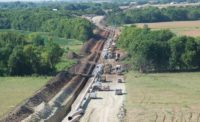After five years of delays and rejections, TransCanada has finally received approval from the U.S. government to build the cross-border section of its Keystone XL pipeline — but construction is unlikely to begin for at least a year.
Approval of the line was announced March 24 by President Trump alongside TransCanada President Russ Girling. Girling brought with him Sean McGarvey, president of the North America's Building Trades Unions, and representatives from Quanta Services, which will build the pipeline.
“There’s thousands of people that are just ready and itching to get to work,” Girling said.
The 1,200-mile pipeline would move up to 830,000 barrels of tar sands oil per day from Hardisty, Alberta, to Steele City, Nebraska. Building of the line is expected to support 3,900 direct construction jobs and 42,100 construction-related jobs over its two-year construction period, according to the Record of Decision from the State Dept. The line would support 35 permanent employees when finished.
But the line doesn’t have an approved route in Nebraska, where opponents successfully challenged a previous Keystone route that crossed the state’s Ogallala water aquifer and the sensitive Sand Hills region. The state’s Public Service Commission is currently reviewing TransCanada’s latest application for a route that would avoid the aquifer. That review is expected to take up to a year.
“I am hopeful that the remaining review by the Nebraska Public Service Commission will be completed swiftly so that the thousands of hard-working men and women of the building trades who have testified, rallied and supported this project — over the course of seven years of review—can get to work,” said Terry O’Sullivan, general president of the Laborers' International Union of North America.
Alberta-based TransCanada originally applied for a cross-border permit to build this section of the pipeline in 2012. In 2015, Secretary of State John Kerry determined the line was not in the national interest because, among other things, it would undercut U.S. credibility in urging other countries to address climate change.
But in January, President Trump ordered the State Dept. to review that decision.
In the March 24 Record of Decision, the State Dept. dismissed Kerry’s reasons, and says the U.S. is taking “numerous developments” related to climate change. Approving the pipeline would support U.S. priorities relating to energy security, economic development and infrastructure, according to the department.
The Record of Decision draws heavily on a supplemental environmental impact statement released in 2014 and the comment periods that occurred in the scoping and creation of the SEIS.
“The department will ensure that TransCanada follows and implements all mitigation measures outlined in the Supplemental EIS and supporting documents,” according to a State Dept. official. “Such concerns were identified and addressed in concert with tribal, state and local authorities.”
Environmental groups have said a decision that uses the 2014 SEIS would be outdated because the price of oil has fallen from about $100/barrel to $50/barrel.
In its decision, the State Dept. says Canadian oil sands are still viable under current market conditions because the region can produce oil at lower prices.
The Record of Decision also addresses a 2016 report from the National Academy of Sciences that found diluted bitumen, the type of oil that will be moved through Keystone XL, is difficult to clean up after a spill. The State Dept., in its decision, says that conditions on the pipeline, already in place in the SEIS, will adequately mitigate any spills.
Environmental groups, though, still say the decision is a bad one.
"Keystone XL is all risk and no reward for the American people. It remains, and always will be, a threat to our land, water and climate,” said Rhea Suh, president of the Natural Resources Defense Council in a statement. “Today's decision can never change those facts. We'll use every tool in the kit to stop this dangerous tar sands oil pipeline project."





